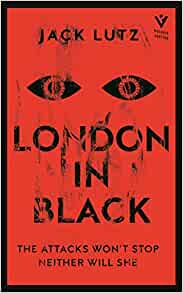Want a gritty, dystopian drama?
Try changing trains on the Tube at rush hour.
That’s what I was doing when the idea for my debut thriller, London in Black, popped into my head. The main character showed up first: DI Lucy Stone, PTSD-stricken survivor of city-wide terror attacks. Flashback-plagued, sleep-avoidant, working all night in the tiny flat she’s painted entirely black. Lucy just sort of grabbed me as I stood there on the Canada Water platform:
Right, here’s me then, now write.
And so I started plotting. By the time I got off the Tube, I had the basic story. A murdered scientist. A London rocked by terror. A cop with an awful secret, tearing the world apart in search of a drug she needs to survive.
Fine, but -- the story was set in 2029, in the future. Which meant…now I needed a world.
Of course, our dystopias are shaped by the world around us. Our fears, our realities. I knew what scared me most about the present, so I used that to shape the themes, the basic plot. And part of the 2029 world I was creating followed directly on from that plot -- a London decimated by nerve gas attacks would have all sorts of chemical weapons-ey kit in it, right? -- but I needed more than that.
I needed details.
Tiny things, loads of them. The sort that no reader notices individually…but without them piling up all over the place, my fictional future London would feel a bit too much like the London of today.
What did I have to work with?
I had a cop suffering from flashbacks. Crippling, awful, scream-your-head-off flashbacks. Lucy Stone isn’t just haunted by her past – she relives it, over and over and over. A word, a sound, the graze of a fingertip … anything can send her hurtling into her past, an unstoppable movie unfolding all around her. In her worst moments, Lucy’s present becomes her past.
So when it came to building my dystopian future London, I decided—
Let’s use the past.
I love London. I love exploring it, reading about it, talking about it. My library is stuffed with books on London history, and so I began digging around, scavenging for little details, anything I could use to flesh out Lucy’s world.
I didn’t need to go too far back in time at first. My story required nerve gas attacks, spread across the entire city — how to do that? Well, I’d seen maps of London covered with little red dots before: the sites of bombs dropped during the Blitz. And I’d spotted old bomb shelter signs on London walls — faded, ghostly, but still there, if you know where to look.
So in London in Black, terror comes from above. Not bombers dropping incendiaries, but drones releasing a novel nerve agent: the horrors of the past, brought into the future.
But for most of my details, I went further back than World War II. Much further back. All the way back to one of the most tumultuous periods in the city’s history: the 17th century. The details of my London 2029 were shaped by the 1600s, by a London ravaged by fire and disease, plot and turmoil.
I dug into whatever materials I could find. Modern scholars. Contemporary writers — Pepys, Defoe, Jonson. Broadsheets and pamphlets, sermons and diaries. Even a 17th century plague amulet.
In the past, inspiration is everywhere. I decided my book simply had to have a survivor-blaming, for-profit, online religious cult in the mix – every book should, right? – so I looked for inspiration to the ravings of eccentric 17th century divines. When I needed a doctor, I read about 17th century physicians. Plotters? Revolutionaries? Body removers? Check, check, check.
I pulled from the sights of London’s past. The sounds. The rumours.
Even the graffiti Lucy passes on the street echoes words scrawled on walls centuries ago.
And the best part was, I was setting the novel in London. Which meant I could set my 2029 scenes in the very same spots where all these things happened, long ago, and hope that the past might somehow bleed through, might help create the richness of the dystopian world I was trying to build.
Want to evoke the feeling of a frenzied religious meeting from centuries ago? Set it in an old church. I used St Olave’s Hart Street, with its ghoulish 17th century gateway of skulls and bristling spikes, lurking amidst modern office blocks and sandwich shops.
I stuck pottery studios on top of long-vanished pottery works. Plotters’ safe houses on top of plotters’ safe houses. Even mass graves on top of plague pits.
Throughout the novel, the voice of Lucy’s fiancée, Simon – a London tour guide in training – pops into her head, unbidden, as she criss-crosses her London of 2029. Do you know what you’re walking on, mate? Lucy doesn’t always remember the details, but she senses the past all around her as she hunts her life-saving antidote. And I hope readers will sense it, too.
Want a scary future? Check out the past.
It’s fucking terrifying.

LONDON IN BLACK by Jack Lutz
Published by Pushkin Vertigo,
Hbk £14.99 June 02, 2022
"The best dystopian fiction is never really about some hypothetical future, it is about the things we fear in the here and now. Jack Lutz understands this implicitly and uses it here to create a disturbing novel that has the potential to become a cult classic."
Says Adam Colclough in his review. Read it here.